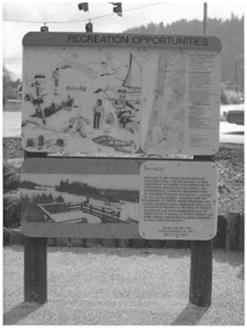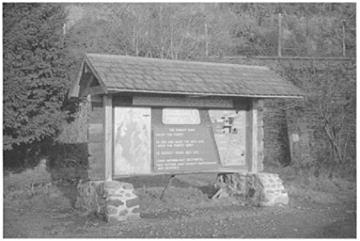To convey the message, a medium is required. There are two main possibilities: leaflets or signboards. Leaflets are an important alternative or supplement to fixed signs. They can be reprinted annually with up-to-date information. As they are carried around by the visitors, they can be easily referred to at any time. Their preparation requires skill in graphic design and printing techniques, for which expert advice should normally be sought.
A fixed signboard, if chosen as the medium, needs to withstand a wide range of changing weather conditions, such as heat and cold or wet and dry. Accidental damage or vandalism may also take place. Hence materials need to be either robust, long lasting and durable, or cheap, easily replaced and short lived. Early techniques used to convey information were either some form of printed material such as paper protected by either glass or Perspex (Plexiglas), painted wooden panels normally routed (often freehand) with the information, or (later) the use of screen-printed panels. All these media are limited in their durability when placed in the open air. Paper gets damp, printing fades, paint cracks and peels, and all may be damaged by accident or vandalism and need frequent maintenance. In addition, some of these techniques limited the quality of graphic design that could be achieved.
The following paragraphs describe materials that can be considered.
Solid wood panels
Wood used outdoors always has the tendency to move or distort by shrinkage, swelling or warping as temperatures and moisture conditions vary. This poses problems for many types of printing, painting or graphic design. The choice of wood is important. Closegrained, slow-grown varieties of hardwood or softwood are preferred, as these are less likely to split and can be finished smooth for the application techniques described below. Durability is also important. Some species are naturally more durable than others although some, like western red cedar, are highly durable but not good for the application of printing, routing or sandblasting. Fir, pine, larch, oak or chestnut are among the better woods to use, although resinous conifers can cause problems for paint application.
The message can be applied using the following techniques:
|
![]()
(a) Information about facilities conveyed in text occupies a lot of space. (b) The same information presented using symbols takes up less space, is quicker and easier to read, and needs no translation into foreign languages.
|
An example of an information sign provided at the Oregon Dunes National Recreation Area, Oregon, USA. Screen-printed on the reverse of Perspex sheets, this presents information in several ways: a map of the whole area, sketches of the range of activities, a view of a nearby attraction, and a message explaining the purpose of the area and its designation. This message starts ‘Dear visitor’, but appears to be signed ‘Public Law 92-260’! |
– Routing. Text, diagrams and maps can be engraved into the surface using hand-held or computer-guided routers. These produce very fine lines and accurate reproductions of text types and symbols. The routed information can be left natural, or can be infilled with paint of different colours. However, routing is best used for simple graphic designs. Complex maps, for example, are beyond the scope of the technique.
– Sandblasting. This method uses sandblasting to erode and cut away areas of wood between the letters or symbols, which then stand out in relief. The grain of the wood also becomes more obvious, often making attractive textures. The information is made into a mask, which is overlaid onto the panel surface before sandblasting. As with routing, the technique has limitations, and should be used for what it is best at: simple bold type, symbols or diagrams. The finished panel can be painted or left natural.
– Screen printing. Smooth-surfaced panels can be screen printed in one or several colours. Quite fine detail is possible depending on the original surface quality. However, such printing weathers poorly unless protected by a varnish of some sort.
|
This sign structure, formerly at Grizedale Forest in the English Lake District, is an example of a once commonly used type. It is massive, made of many parts, and dominates the messages it bears. It is costly to build and to maintain. The information is crude, using hand-held routers or simple painting, which needs protection from the weather but cannot present much detail. This overdone design is now redundant with the advent of more sophisticated and durable materials. |





